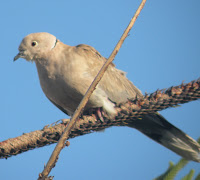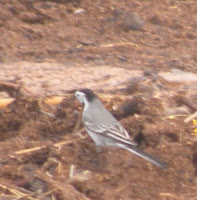
The railway line, Janzour, West Tripoli
This weekend I stayed in Tripoli. I tend to do a trip into the countryside every second week to help my wallet and to give me chance to keep up to date with logging all my data (and blog). This week though I did some extra birding
very locally. After a tip-off from a work colleague I think I now know the best place to bird
on foot if you have just 24 hours to spare and you are visiting
Tripoli.
A few years back the Government decide it would build a railway from the Tunisian border to the Egyptian border. The land was put aside and no development can take place on a 50 metre wide corridor. The railway line is probably years away from being built. In Tripoli, the rail route links plenty of green sites by a wild life corridor. I found out over March 18th to March 20th that it makes for great sub-urban birding.
The best start point is just south of Janzour cemetery. It's best to walk eastwards towards Seraj in the afternoon and westwards out of Janzour in the mornings if you want to avoid walking and birding into the sun.
I saw a surprising number and type of "rural " birds! This time of year there is a state of flux. I saw a mix of residents, winterers, summer visitors and passage birds.
Before I set out I noticed that the bushy and woody area in front of my flat has got some new
blackcap in the bushes or perhaps the old ones had returned. They were joined (at least until today) by a single
greenfinch in the trees. I had thought these winter visitors had left the resident
serin,
spanish sparrow and
laughing dove to it. Meanwhile one summer visitor, the
turtle dove arrived almost a week ago in the parkland
.After inspecting myown frontyard (as described above) I went walking at the crack of dawn along the railway which is 10 minutes from my flat. I was shocked to see a
stone curlew almost immediately by the side of the rail corridor. I soon saw
barbary partridge too. In fact I later saw barbary partridge many times on different parts of the line.


stone curlew (left) barbary partridge (right)
The most amazing sight however was soon to come. In one field I counted 25 stone curlew!
It was still only 9 am the first time I saw them. They were noisy too. As soon as one of them saw me they all froze. They looked really stupid. 25 stone curlew pretended to be statues in one field.
I assume these were wintering birds gathering to leave for Eastern Europe. We have our own resident birds but let me assure you they don't pack in at a density of 25 per field. As a check, I visited the same site two days later at 9am and at 12 noon and they were still there. If anything there were more. I checked the adjacent fields and there were no curlews there.
I am not disclosing the exact location because stone curlews are a favourite prey of falconers. It's not a big sport in the Tripoli area and I don't want it to become so!

Five stone curlew out of 25 in one field - Tripoli area
Three feral dogs were around the second time I visited the
stone curlew. I saw two brave stone curlew march straight up one of the dogs which then ran away.
As well as the stone curlew I saw a few other lingering wintering birds along the rail line. In the far west of my walk I spotted my first
blackbird since I moved to Libya six months ago! It was a lovely sight. I had heard them several times before. It would appear they like shaded well watered areas such as irrigated citrus groves most of which are private property. The other wintering birds I observed was a
robin and
a few
chiffchaff in different places
. And finally there are still a few
stonechat around but there numbers are drastically down on two weeks ago.
While some wintering birds are still lingering, some summer visitors have arrived. I saw more turtle doves in the agricultural areas. But they were very jumpy when I tried to photograph with my basic camera. One stretch of the line had several barn swallow skimming the air for insects.
The walk was also surprisingly good for seeing many of the residents too. There were several families of
fulvous babbler along the route.

fulvous babblers (above)
Hoopoe was also common on the ground, and laughing dove in the trees and on wires. I have to be more careful with identification of doves with the return of the turtle dove. There are also rock dove and pigeon around. Serin and spanish sparrow were very common.


suburban hoopoe (left) and laughing dove (right)


suburban serin (left) and spanish sparrow (right)
It is already the breeding season for desert grey shrikes. I came across two groups of fledglings.

One fledgling desert grey shrike in a group of three


the two local breeding subspecies of desert grey shrike - algeriensis (left) and elegans (right)
Once again the books aren't very accurate with the distribution of
desert grey shrike in Libya. Contrary to books, the main breeding sub-species even on the coast is elegans. It outnumbers algeriensis by at least 3 or 4 to one. Just to add to the mix, in mid winter they are joined by a few iberian grey shrike which are most obviously different.
Another breeder which is posing me a sub-species issue is the sardinian warbler. Like the stone curlew, the winter population is greater than those who stay behind. However, I am beginning to question whether all the residents are of the sub-species melanocephala. A very few are decidedly lighter (like the one below) . It's a long shot but I wonder if it is the sub species valverdei which is found in southern Morrocco.


A light coloured sardinian warbler Another resident breeder which was seen several times during my walks is cattle egret. On one occasion it was next to a cow, true to its name. It's not even in the new Collin's guide as being in Libya at all. But I have now seen it near Wadi Kaam and now Tripoli. It is recorded by others as being quite numerous near Benghazi too. It only seems to inhabit the wettest meadows in Libya created by irrigation or a high water table.


Cattle egret- Tripoli
Other less common resident birds were also present. A flock of goldfinch briefly made an appearance and linnet was seen once.

local linnet- railway line, Tripoli
Even crested lark make it into the urban area. Several can be seen at Janzour cemetery near the rail corridor. The final resident I met on my walks was kestrel.
There were naturally some passage birds as well. I met just one sub-alpine warbler. It was the only bird in an area which was active at one o'clock in the afternoon. Maybe Tripoli at midday is cooler than where it has just come from! I had a definite identification on one isabelline wheatear and two female whitchat. Although the passage birds lacked numbers there was at least some variety.
All in all I had a surprisingly good time virtually on my doorstep.
































































